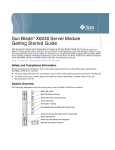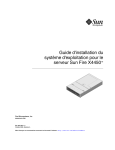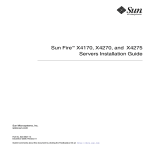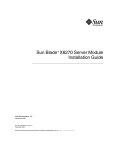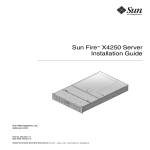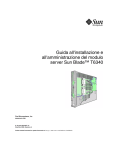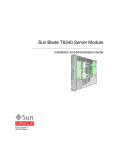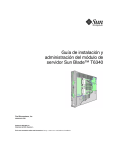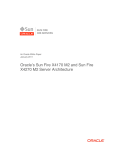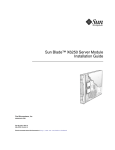Download Sun Blade X6240 Server Module Installation Guide
Transcript
Sun Blade™ X6240 Server Module Installation Guide Sun Microsystems, Inc. www.sun.com Part No. 820-3968-10, Rev. A June 2008 Submit comments about this document at: http://www.sun.com/hwdocs/feedback Copyright © 2008 Sun Microsystems, Inc., 4150 Network Circle, Santa Clara, California 95054, U.S.A. All rights reserved. Sun Microsystems, Inc. has intellectual property rights relating to technology embodied in the product that is described in this document. In particular, and without limitation, these intellectual property rights may include one or more of the U.S. patents listed at http://www.sun.com/patents and one or more additional patents or pending patent applications in the U.S. and in other countries. Parts of the product may be derived from Berkeley BSD systems, licensed from the University of California. UNIX is a registered trademark in the U.S. and in other countries, exclusively licensed through X/Open Company, Ltd. Sun, Sun Microsystems, the Sun logo, Java, Solaris, Sun Blade, docs.sun.com, Sun Fire and the Solaris logo are trademarks or registered trademarks of Sun Microsystems, Inc. in the U.S. and other countries. Microsoft is a trademark or registered trademark of Microsoft Corporation or its subsidiaries in the United States and Other countries. Windows is a trademark or registered trademark of Microsoft Corporation or its subsidiaries in the United States and Other countries. The Adobe. logo is a registered trademark of Adobe Systems, Incorporated. Use of any spare or replacement CPUs is limited to repair or one-for-one replacement of CPUs in products exported in compliance with U.S. export laws. Use of CPUs as product upgrades unless authorized by the U.S. Government is strictly prohibited. DOCUMENTATION IS PROVIDED "AS IS" AND ALL EXPRESS OR IMPLIED CONDITIONS, REPRESENTATIONS AND WARRANTIES, INCLUDING ANY IMPLIED WARRANTY OF MERCHANTABILITY, FITNESS FOR A PARTICULAR PURPOSE OR NON-INFRINGEMENT, ARE DISCLAIMED, EXCEPT TO THE EXTENT THAT SUCH DISCLAIMERS ARE HELD TO BE LEGALLY INVALID. Copyright © 2008 Sun Microsystems, Inc., 4150 Network Circle, Santa Clara, California 95054, Etats-Unis. Tous droits réservés. Sun Microsystems, Inc. détient les droits de propriété intellectuels relatifs à la technologie incorporée dans le produit qui est décrit dans ce document. En particulier, et ce sans limitation, ces droits de propriété intellectuelle peuvent inclure un ou plus des brevets américains listés à l’adresse http://www.sun.com/patents et un ou les brevets supplémentaires ou les applications de brevet en attente aux Etats - Unis et dans les autres pays. Des parties de ce produit pourront être dérivées des systèmes Berkeley BSD licenciés par l’Université de Californie. UNIX est une marque déposée aux Etats-Unis et dans d’autres pays et licenciée exclusivement par X/Open Company, Ltd. Sun, Sun Microsystems, le logo Sun, Java, Solaris, Sun Blade, docs.sun.com, Sun Fire et le logo Solaris sont des marques de fabrique ou des marques déposées de Sun Microsystems, Inc. aux Etats-Unis et dans d’autres pays. Microsoft sont est marques de fabrique ou des marques déposées de Microsoft Corporation ou de sa filiale aux Etats-Unis et dans d’autres pays. Windows est une marque de fabrique ou une marques déposée de Microsoft Corporation ou de sa filiale aux Etats-Unis et dans d’autres pays. Le logo Adobe est une marque déposée de Adobe Systems, Incorporated. L’utilisation de pieces detachees ou d’unites centrales de remplacement est limitee aux reparations ou a l’echange standard d’unites centrales pour les produits exportes, conformement a la legislation americaine en matiere d’exportation. Sauf autorisation par les autorites des EtatsUnis, l’utilisation d’unites centrales pour proceder a des mises a jour de produits est rigoureusement interdite. LA DOCUMENTATION EST FOURNIE "EN L’ETAT" ET TOUTES AUTRES CONDITIONS, DECLARATIONS ET GARANTIES EXPRESSES OU TACITES SONT FORMELLEMENT EXCLUES, DANS LA MESURE AUTORISEE PAR LA LOI APPLICABLE, Y COMPRIS NOTAMMENT TOUTE GARANTIE IMPLICITE RELATIVE A LA QUALITE MARCHANDE, A L’APTITUDE A UNE UTILISATION PARTICULIERE OU A L’ABSENCE DE CONTREFACON. Please Recycle Contents Preface 1. vii Setting Up the Server Hardware 1 Installation Overview and Terms 1 Inserting the Server Module ▼ 2 To Insert the Server Module 3 Powering On and Powering Off the Server Module ▼ To Apply Standby Power for Initial Service Processor Configuration ▼ To Power on Main Power for All Server Module Components ▼ To Shut Down Main Power Mode Using a Dongle Cable for Testing ▼ 2. 5 Setting Up the Server Software 11 Integrated Lights Out Manager 11 7 8 12 About the Preconfigured Administrator Account ILOM Connection Overview 5 8 To Use a Dongle Cable for Testing What Is a Service Processor? 5 12 13 Connecting to the Server Module ILOM 13 iii Option 1: Connecting to ILOM Through the Chassis Serial Connector ▼ To Connect to ILOM Through the Chassis Serial Connector Option 2: Connecting to ILOM Through a Dongle Cable ▼ To Connect to ILOM Using a Dongle Cable 19 19 20 ▼ To Log In and Out of the ILOM CLI ▼ To Log In and Out of the ILOM Web GUI Configuring the ILOM IP Address 3. 20 20 23 ▼ To View the ILOM IP Address ▼ To Configure the ILOM IP Address Using BIOS Setup Utility ▼ To Configure the ILOM IP Address Using DHCP ▼ To Configure the ILOM IP Address Using the CLI 23 26 29 Configuring the Preinstalled Solaris 10 Operating System 31 32 Installation Worksheet 32 Configuring the Preinstalled Solaris 10 Operating System 36 ▼ To Configure the Preinstalled Solaris 10 OS ▼ To Redirect the Console Output to the Video Port (Optional) Configuring X6240 Server Module RAID Drives RAID Drive Overview RAID Drive Options 36 38 39 39 40 Mirroring the Preinstalled Solaris OS with LSI RAID ▼ 23 25 Setting Up Platform Operating System and Driver Software Before You Begin 14 18 Option 3: Connecting to ILOM Through the Ethernet Port Logging In and Out of ILOM 14 40 To Create a Mirror Image of the Preinstalled Solaris OS 41 Creating a RAID Set to Incorporate a Preinstalled OS Using the Sun StorageTek REM Card 42 ▼ iv To Incorporate a Preinstalled Solaris OS Using the Sun StorageTek REM Card 42 Sun Blade X6240 Server Module Installation Guide • June 2008 Solaris 10 Operating System User Information Solaris 10 User Documentation Solaris 10 OS Training 43 44 Using the Solaris Installation Program Sun Java Enterprise System Sun Studio 11 44 44 44 Reinstalling the Solaris Operating System Downloading Software 4. 43 45 45 Configuring the Preinstalled Microsoft Windows Server 2003 R2 Operating System 47 Before You Begin 48 Hardware and Software Prerequisites 48 Establish a Console Connection to the Sun Blade Server Module Initial Setup of Preinstalled Windows Server 2003 R2 OS ▼ 49 To Perform the Initial Setup of the Preinstalled Windows OS Configuring X6240 Server Module RAID Drives RAID Drive Overview RAID Drive Options 49 50 51 52 Mirroring the Preinstalled Windows OS with LSI RAID ▼ 48 52 To Create a Mirror Image of the Preinstalled Windows OS 53 Creating a RAID Set to Incorporate a Preinstalled OS Using the Sun StorageTek REM Card 54 ▼ To Incorporate a Preinstalled Windows OS Using the Sun StorageTek REM Card 54 Important Information Sun Link 56 Recovery Media Kit Index 56 57 59 Contents v vi Sun Blade X6240 Server Module Installation Guide • June 2008 Preface This Sun Blade X6240 Server Module Installation Guide contains procedures for installing the server module in a chassis, connecting to the service processor, and configuring the preinstalled Solaris™ or Windows Server® 2003 R2 Operating System. Using UNIX Commands This document might not contain information about basic UNIX® commands and procedures such as shutting down the system, booting the system, and configuring devices. Refer to the following for this information: ■ Software documentation that you received with your system ■ Solaris™ Operating System documentation, which is at: http://docs.sun.com vii Shell Prompts Shell Prompt C shell machine-name% C shell superuser machine-name# Bourne shell and Korn shell $ Bourne shell and Korn shell superuser # Typographic Conventions Typeface* Meaning Examples AaBbCc123 The names of commands, files, and directories; on-screen computer output Edit your.login file. Use ls -a to list all files. % You have mail. AaBbCc123 What you type, when contrasted with on-screen computer output % su Password: AaBbCc123 Book titles, new words or terms, words to be emphasized. Replace command-line variables with real names or values. Read Chapter 6 in the User’s Guide. These are called class options. You must be superuser to do this. To delete a file, type rm filename. * The settings on your browser might differ from these settings. Related Documentation The documents listed in the following table are available online at: http://docs.sun.com At that site, search for the Sun Blade™ X6240 Server Module. viii Sun Blade X6240 Server Module Installation Guide • June 2008 Note – The last two digits of the documentation part number identify the latest version of the product documentation that is available for download (or viewing online). For example: 820-xxxx-XX. Title Content Part Number Format Sun Blade X6240 Server Module Product Notes Late-breaking information about the server module. 820-3972 PDF HTML Sun Blade X6240 Server Module Getting Started Guide Basic installation information for setting up the server module. 820-3975 PDF Print Sun Blade X6240 Server Module Installation Guide Detailed installation information for setting up the server module. 820-3968 PDF HTML Print option Sun Blade X6240 Server Module Operating System Installation Guide Installation instructions for the Solaris and Linux operating systems. 820-3969 PDF HTML Sun Blade X6240 Server Module Windows Operating System Installation Guide Installation instructions for the Windows Server operating system. 820-3970 PDF HTML Sun Blade X6240 Server Module Service Manual Information and procedures for maintaining and upgrading the server module. 820-3971 PDF HTML x64 Servers Utilities Reference Manual Information for using applications and utilities common to x64 servers and server modules. 820-1120 PDF HTML Sun Integrated Lights Out Manager 2.0 User’s Guide ILOM features and tasks that are common to servers and server modules that support ILOM. 820-1188 PDF HTML Sun Integrated Lights Out Manager Supplement for Sun Blade X6240 Server Module ILOM information that is specific to the server module. 820-3974 PDF HTML Sun Blade X6240 Server Module Safety and Compliance Manual Hardware safety and compliance information for the server module. 820-4411 PDF Important Safety Information for Sun Hardware Systems Multilingual hardware safety and compliance information for all Sun hardware systems. 816-7190 Print Preface ix Support, and Training Sun Function URL Support http://www.sun.com/support/ Training http://www.sun.com/training/ Product Updates For product updates that you can download for the Sun Blade X6240 server module, please visit the following web site: http://www.sun.com/download/ Find the Hardware Drivers section and click x64 Servers & Workstations. The Sun Blade X6240 server module site contains updates for firmware and drivers, as well as CD-ROM .iso images. Third-Party Web Sites Sun is not responsible for the availability of third-party web sites mentioned in this document. Sun does not endorse and is not responsible or liable for any content, advertising, products, or other materials that are available on or through such sites or resources. Sun will not be responsible or liable for any actual or alleged damage or loss caused by or in connection with the use of or reliance on any such content, goods, or services that are available on or through such sites or resources. x Sun Blade X6240 Server Module Installation Guide • June 2008 Sun Welcomes Your Comments Sun is interested in improving its documentation and welcomes your comments and suggestions. You can submit your comments by going to: http://www.sun.com/hwdocs/feedback Please include the title and part number of your document with your feedback: Sun Blade X6240 Server Module Installation Guide, part number 820-3968-10 Preface xi xii Sun Blade X6240 Server Module Installation Guide • June 2008 CHAPTER 1 Setting Up the Server Hardware This chapter describes how to insert the Sun Blade X6240 server module into the chassis, how to power on and power off the server module, and how to connect the dongle cable to the server module. This chapter contains the following topics: ■ “Installation Overview and Terms” on page 1 ■ “Inserting the Server Module” on page 2 ■ “Powering On and Powering Off the Server Module” on page 5 ■ “Using a Dongle Cable for Testing” on page 8 Installation Overview and Terms Note the following terms used in this book: ■ The term server module refers to the blade or blade server hardware. ■ The term chassis refers to the modular system hardware. ■ The term Intergrated Lights Out Manager (ILOM) refers to the built-in system management software that enables the monitoring and managing of installed components in the chassis and server module. ■ The term service processor (SP) refers to the hardware portion of the ILOM. The SP is capable of functioning independently of the server operating system as well as in power off situations. ■ The term chassis management module (CMM) refers to the chassis-level ILOM. After unpacking your server module, perform the following tasks: 1. Insert the server module into the chassis. See “Inserting the Server Module” on page 2. 1 2. Connect all cables, peripherals, and power cords to the chassis. See the installation guide for your chassis. 3. Power on the server module. See “Powering On and Powering Off the Server Module” on page 5. 4. Connect to the server module through the service processor on the chassis management module or through the service processor on the server module itself. This book assumes that the service processor software on the chassis, called the CMM ILOM, is already configured. See Chapter 2, “Setting Up the Server Software” on page 11 of this guide. 5. Configure either the preinstalled Solaris or Windows Server 2003 R2 Operating System, or install a supported operating system of your choice. Refer to “Configuring the Preinstalled Solaris 10 Operating System” on page 36 or “Configuring the Preinstalled Microsoft Windows Server 2003 R2 Operating System” on page 47. See also the Sun Blade X6240 Server Module Operating System Installation Guide (820-3969) or the Sun Blade X6240 Server Module Windows Operating System Installation Guide (820-3970). 6. Customize your server, as needed. For more information, see the Sun ILOM documentation: ■ Sun Integrated Lights Out Manager 2.0 User’s Guide (820-1188) ■ Sun Integrated Lights Out Manager (ILOM) Supplement for Sun Blade X6240 Server Module (820-3974) ■ Addendum to the Sun Integrated Lights Out Manager 2.0 User’s Guide (820-4198) Inserting the Server Module Caution – Before handling components, attach an electrostatic discharge (ESD) wrist strap to bare metal on the chassis. Both the front and back of the chassis have grounded locations. The system’s printed circuit boards and hard disk drives contain components that are extremely sensitive to static electricity. 2 Sun Blade X6240 Server Module Installation Guide • June 2008 ▼ To Insert the Server Module 1. Locate the desired server module slot in the chassis. 2. (Optional) Remove the slot filler panel, if applicable. Pull the lever out and eject the filler panel. Note – Other filler panels should remain in any unused slots as they ensure the chassis complies with FCC limits on electromagnetic interference (EMI). 3. Position the server module vertically so that the ejectors are on the right and extended outwardly. The following illustrations show the server module being inserted into the Sun Blade 6000 Modular System; your chassis might differ. See box 1 in FIGURE 1-1. Chapter 1 Setting Up the Server Hardware 3 FIGURE 1-1 Inserting the Server Module Into the Chassis 4. Push the server module into the slot until the server module stops. See Box 2 in FIGURE 1-1. 5. Rotate the ejectors down until they snap into place. The server module is now flush with the chassis and the ejectors are locked. See Boxes 3 and 4 in FIGURE 1-1. 4 Sun Blade X6240 Server Module Installation Guide • June 2008 Powering On and Powering Off the Server Module You have to apply only standby power to the server module at this point so that you can perform initial configuration of the service processor (SP). Procedures for powering on to main power mode and for shutting down from main power mode are also included in this section. ▼ To Apply Standby Power for Initial Service Processor Configuration Use this procedure to apply standby power to the service processor (SP) before initial configuration. 1. Connect grounded AC power cords to the AC power connectors on the back panel of the chassis and to grounded AC power outlets. For details, see your chassis documentation. In standby power mode, the blue (Ready to Remove) LED is illuminated, indicating that the SP is working. See FIGURE 1-2 for the LED location. Note – At this point, standby power is supplied only to the service processor and power supply fans. 2. Continue with initial software setup tasks, as described in Chapter 2 of this guide. ▼ To Power on Main Power for All Server Module Components 1. Verify that standby power is on. In standby power mode, the blue (Ready to Remove) LED is illuminated. See FIGURE 1-2. Chapter 1 Setting Up the Server Hardware 5 2. Use a pointed object or stylus to press and release the recessed Power button on the server module front panel. When main power is applied to all server module components, the green Power LED above the Power button lights and remains lit. FIGURE 1-2 Sun Blade X6240 Server Module Front Panel 1 2 3 4 5 6 7 8 9 10 Legend 6 1 White LED–Locate 2 Blue LED–Ready to Remove 3 Amber LED–Service Action Required 4 Green LED–Power 5 Power button/standby 6 Non-Maskable Interrupt (NMI) button (Service only) 7 Universal Connector Port (UCP), used for dongle cable 8 Green LED–Disk OK 9 Amber LED–Disk Service Action Required 10 Blue LED–Disk Ready to Remove Sun Blade X6240 Server Module Installation Guide • June 2008 ▼ To Shut Down Main Power Mode To power off the server module from main power mode, use one of the following two methods: ■ Graceful shutdown. Use a ballpoint pen or other stylus to press and release the Power button on the front panel. This causes Advanced Configuration and Power Interface (ACPI) enabled operating systems to perform an orderly shutdown of the operating system. Servers not running ACPI-enabled operating systems will shut down to standby power mode immediately. ■ Emergency shutdown. Press and hold the Power button for four seconds to force main power off and to enter standby power mode. When main power is off, the blue (Ready to Remove) LED on the front panel will be illuminated, indicating that the server module is in standby power mode. Note – To power off the server module completely, you must disconnect the AC power cords from the back panel of the chassis. This will remove power from all the blades in the chassis. Chapter 1 Setting Up the Server Hardware 7 Using a Dongle Cable for Testing Your chassis ships with a dongle cable. The dongle enables you to plug devices directly into the front of the server module for testing. Caution – The dongle cable should be used only for configuration and service purposes. It should be disconnected from the server module when the configuration or servicing operation is completed. If you have a dongle cable connected to a server module, it must be removed before closing the door of a rack cabinet. The dongle cable may be damaged if it is not removed before the cabinet door is closed. ▼ To Use a Dongle Cable for Testing 1. Insert the dongle cable into the universal connector port (UCP) on the server module front panel. See FIGURE 1-3. 2. Connect device to the dongle cable connections, as appropriate. 8 Sun Blade X6240 Server Module Installation Guide • June 2008 FIGURE 1-3 Dongle Cable Connections 2 3 1 Legend Connector Status 1 Dual USB 2.0 connectors Used 2 Serial port connector Used 3 VGA video connector Used Chapter 1 Setting Up the Server Hardware 9 10 Sun Blade X6240 Server Module Installation Guide • June 2008 CHAPTER 2 Setting Up the Server Software This chapter describes how to configure and access the Sun™ Integrated Lights Out Manager software, and how to set up the platform operating system and driver software. This chapter contains these topics: ■ ■ “Integrated Lights Out Manager” on page 11 ■ “What Is a Service Processor?” on page 12 ■ “About the Preconfigured Administrator Account” on page 12 ■ “ILOM Connection Overview” on page 13 ■ “Connecting to the Server Module ILOM” on page 13 ■ “Configuring the ILOM IP Address” on page 23 “Setting Up Platform Operating System and Driver Software” on page 29 Integrated Lights Out Manager Sun Integrated Lights Out Manager (ILOM) is built-in system management software that enables you to control your system. Using ILOM, you can monitor and manage the components installed in your chassis and server modules, configure network information, view and edit hardware configurations, monitor vital system information, and manage user accounts. You can access ILOM through several interfaces, such as the web browser interface, command-line interface (CLI), SNMP interface, as well as the IPMI interface. 11 Note – This chapter describes how to access ILOM through the command-line interface and web browsers. For other methods, see the Sun Integrated Lights Out Manager 2.0 User’s Guide (820-1188). What Is a Service Processor? A service processor (SP) is a component, located on the server module’s motherboard, that operates independently of the other hardware in the system. The SP has its own IP address and MAC address and is capable of operating regardless of the state of the other system hardware. In a server module, the service processor can operate whether the server module is fully operational, powered down, or somewhere in between. The chassis management module (CMM) and every server module in the chassis has its own service processor. Note the following terms used in this book: ■ The term chassis management module (CMM) refers to the hardware module on the chassis. ■ The CMM ILOM refers to the ILOM software on the CMM. ■ The server module SP (service processor) refers to the server module’s SP hardware. ■ The server module ILOM refers to the ILOM software on the server module SP. Note that other server modules might have different service processors. About the Preconfigured Administrator Account The server module ILOM is shipped with a preconfigured Administrator account: User name: root Password: changeme The preconfigured Administrator account, known as root, cannot be deleted or changed, other than changing its password. This account offers built-in administrative privileges (read and write access) to all service processor features and commands. 12 Sun Blade X6240 Server Module Installation Guide • June 2008 Note – The CMM ILOM is shipped with an identical preconfigured Administrator account, with user name root and the default password set to changeme. ILOM Connection Overview FIGURE 2-1 shows the connections to the server module ILOM. FIGURE 2-1 ILOM Connection Options Chassis CMM ILOM Serial Connector CLI only Net 0 CLI or WebGUI Ethernet Switch Server Modules ILOM Dongle Cable CLI only Connecting to the Server Module ILOM Before you continue installing the server module, you must ensure that you can connect to ILOM. You can connect to the server module ILOM using one of several methods listed next and described in the corresponding sections. Chapter 2 Setting Up the Server Software 13 Note – Option 1 and option 2 enable you to connect to ILOM without knowing ILOM’s IP address. These options provide access to ILOM’s command-line interface (CLI) only. Option 3 requires you to know ILOM’s IP address, but supports CLI and web GUI access. Most users configure ILOM’s IP address, then connect to it using Option 3. Instructions for configuring ILOM’s IP address are in “Configuring the ILOM IP Address” on page 23. ■ Option 1. Use the serial connector on the chassis to connect to the CMM ILOM. Then use the CMM ILOM to navigate to the server module ILOM. See “Option 1: Connecting to ILOM Through the Chassis Serial Connector” on page 14. ■ Option 2. Use a dongle cable to establish a serial connection directly to the server module ILOM. See “Option 2: Connecting to ILOM Through a Dongle Cable” on page 18. ■ Option 3. Connect through the Ethernet. This connection supports both CLI and web GUI access. See “Option 3: Connecting to ILOM Through the Ethernet Port” on page 19. The following sections describe each of these methods. Option 1: Connecting to ILOM Through the Chassis Serial Connector The chassis serial connector connects to the CMM ILOM, which provides a command to connect to the server module ILOM. ▼ To Connect to ILOM Through the Chassis Serial Connector You can access the CMM ILOM at any time by connecting a terminal or a PC running terminal emulation software to the RJ-45 serial port on the chassis. The CMM ILOM’s command-line interface (CLI) enables you to connect to the server module ILOM. Before completing this connection, the server module must be installed in the chassis. 1. Verify that your terminal, laptop, or terminal server is operational. 14 Sun Blade X6240 Server Module Installation Guide • June 2008 2. Configure the terminal device or the terminal emulation software to use the following settings: ■ 8N1: eight data bits, no parity, one stop bit ■ 9600 baud (default, can be set to any standard rate up to 57600) ■ Disable hardware flow control (CTS/RTS) 3. Connect a serial cable from the serial port on the chassis to a terminal device. Refer to the chassis documentation for the location of the serial port. Note – The serial port requires the following pin assignments. Note that these are the same as the serial cable connector for the Sun Advanced Lights Out Manager (ALOM) or Remote System Control (RSC). See TABLE 2-1. TABLE 2-1 Pin Serial Management Port Pinouts Signal Description 1 Request To Send (RTS) 2 Data Terminal Ready (DTR) 3 Transmit Data (TXD) 4 Ground 5 Ground 6 Receive Data (RXD) 7 Data Carrier Detect (DCD) 8 Clear To Send (CTS) 4. Press Enter on the terminal device. This establishes the connection between the terminal device and the CMM ILOM. Note – If you connect a terminal or emulator to the serial port before it has been powered up or during its power up sequence, you will see bootup messages. When the system has booted, the CMM ILOM displays its login prompt: SUNCMMnnnnnnnnnn login: The first string in the prompt is the default host name. It consists of the prefix SUNCMM and the CMM ILOM’s MAC address. The MAC address for each service processor is unique. Chapter 2 Setting Up the Server Software 15 5. Log in to the CLI: a. Type the default user name, root. b. Type the default password, changeme. Once you have successfully logged in, the CMM ILOM displays its default command prompt: -> You are now connected to the CMM ILOM CLI. 6. Navigate to the server module ILOM by typing this command: -> cd /CH/BLn/SP/cli Where n is 0 through 9 for server modules 0 through 9 respectively. 7. Type the command start. A prompt appears. 8. Type y to continue or n to cancel. If you typed y, the server module ILOM prompts for its password. Note – The CMM ILOM logs on to the server module ILOM using the user name in the user target under /CH/BLn/SP/cli (where n is the server module number). 9. When prompted, type the password. The default password is changeme. The server module ILOM prompt appears. You are now connected to the server module ILOM. 10. Type exit when you are done. The server module ILOM exits and the CMM CLI prompt appears. 16 Sun Blade X6240 Server Module Installation Guide • June 2008 The following display shows an example of the login screen. -> cd /CH/BL2/SP/cli /CH/BL2/SP/cli -> start Are you sure you want to start /CH/BL2/SP/cli (y/n)? y Password: Type the password to the server module ILOM. Sun(TM) Integrated Lights Out Manager Version 2.0.3.9 Copyright 2008 Sun Microsystems, Inc. All rights reserved. Use is subject to license terms. Warning: password is set to factory default. -> exit Type this command to exit the server module ILOM and return to the CMM ILOM. Connection to 10.6.153.33 closed. Chapter 2 Setting Up the Server Software 17 Option 2: Connecting to ILOM Through a Dongle Cable You can use the dongle cable to connect a terminal directly to the server module ILOM. FIGURE 2-2 shows a dongle cable connected to a server module. Caution – The dongle cable should be used only for configuration and service purposes. It should be disconnected from the server module when the configuration or servicing operation is completed. If you have a dongle cable connected to a server module, it must be removed before closing the door of a rack cabinet. The dongle cable may be damaged if it is not removed before the cabinet door is closed. FIGURE 2-2 Dongle Cable 2 3 1 18 Sun Blade X6240 Server Module Installation Guide • June 2008 Legend Connector Status 1 Dual USB connectors Used 2 Serial port connector Used 3 VGA video connector Used ▼ To Connect to ILOM Using a Dongle Cable 1. Connect a dongle cable to the server module. 2. Connect a terminal or terminal emulator to the RJ-45 connector (labeled as 2 in the figure) on the dongle cable. The ILOM login prompt appears. 3. Type the user name and password when prompted. The default user name is root and the default password is changeme. The server module ILOM prompt appears. 4. When you are done, exit ILOM by typing: -> exit Option 3: Connecting to ILOM Through the Ethernet Port The chassis Ethernet ports provide the most robust method of connecting to ILOM. This connection supports both the CLI and the web GUI. You can connect to ILOM through either the RJ-45 NET MGT 0 Ethernet port or the corresponding network express module (NEM) port. Before you can use the Ethernet connection, you must know ILOM’s IP address. Note – To configure the ILOM IP address, see “Configuring the ILOM IP Address” on page 23. Chapter 2 Setting Up the Server Software 19 Logging In and Out of ILOM You can use either the ILOM command-line interface (CLI) or web GUI to access ILOM. ▼ To Log In and Out of the ILOM CLI ILOM supports Secure Shell (SSH) access to the CLI over the Ethernet. 1. Start an SSH client. 2. To log in to ILOM CLI, type: $ ssh root@ipaddress Where ipaddress is the IP address of the server SP. 3. Type your password when prompted. The default user name is root, and the default password is changeme. For example: $ ssh [email protected] [email protected]'s password: Sun Integrated Lights Out Manager Version 2.0.3.9 Copyright 2008 Sun Microsystems, Inc. All rights reserved. Warning: password is set to factory default. -> 4. To log out of ILOM, type exit. ▼ To Log In and Out of the ILOM Web GUI 1. To log in to the ILOM web GUI, type the IP address of the ILOM service processor into your web browser. The ILOM login screen appears. 20 Sun Blade X6240 Server Module Installation Guide • June 2008 FIGURE 2-3 Web GUI ILOM Login Screen 2. Type your user name and password. When you first try to access the web GUI, it prompts you to type the default user name and password. The default user name and password are: ■ Default user name – root ■ Default password – changeme The default user name and password are in lowercase characters. 3. Click Log In. The web GUI appears. 4. To log out of the web GUI, click the Log Out button at the top right of the web GUI. The ILOM log out screen appears. Caution – Do not use the Log Out button in your web browser to log out from the ILOM web GUI. Chapter 2 Setting Up the Server Software 21 FIGURE 2-4 22 ILOM Log Out Screen Sun Blade X6240 Server Module Installation Guide • June 2008 Configuring the ILOM IP Address This section describes how to view and set the ILOM IP address. It includes the following sections: ■ “To View the ILOM IP Address” on page 23 ■ “To Configure the ILOM IP Address Using BIOS Setup Utility” on page 23 ■ “To Configure the ILOM IP Address Using DHCP” on page 25 ■ “To Configure the ILOM IP Address Using the CLI” on page 26 ▼ To View the ILOM IP Address 1. Log in to the ILOM CLI using any of the methods described in “Connecting to the Server Module ILOM” on page 13. To use the Ethernet SSH connection, you must already know the IP address. 2. Type these commands from the root directory. a. To see all the IP address-related information, type: -> show /SP/network b. To see only the IP address, type: -> show /SP/network/ipaddress ▼ To Configure the ILOM IP Address Using BIOS Setup Utility The BIOS Setup Utility enables you to set the ILOM IP address. You can configure the IP address manually (static) or use DHCP to configure it. 1. Verify the following: ■ Your DHCP server is configured to accept new media access control (MAC) addresses. ■ Your DHCP server is connected to either the corresponding NEM port or the RJ-45 NET MGT Ethernet port. 2. Start the BIOS Setup Utility. a. Boot the system. b. Watch the boot messages. You will see a message that says you can press F2 to enter BIOS setup. Chapter 2 Setting Up the Server Software 23 c. After you see the message, press F2. After some messages and screen changes, the BIOS Setup Utility appears. 3. Select the Advanced tab. The Advanced page appears. 4. Highlight IPMI 2.0 Configuration in the list, then select Enter. The IPMI 2.0 Configuration page appears. 5. Highlight LAN Configuration, then select Enter. The LAN Configuration page appears. 6. On the LAN Configuration page, under IP Assignment, select DHCP or Static. If you selected Static, fill in the IP address, subnet mask, and default gateway at the bottom of the page. 7. Select Commit to save your changes. The BIOS utility automatically updates the address fields. ■ If you selected Static, you are done. ■ If you selected DHCP, the DHCP server assigns an IP address to the server module ILOM. Continue to Step 8. Caution – You must select Commit to save the changes on this page. Using F10 will not save your changes. 8. To find the IP address that DHCP assigned to the server module ILOM, either: ■ Log in to ILOM CLI using option 1 or option 2 (see “Connecting to the Server Module ILOM” on page 13) and enter this command: show /SP/network ■ Look in the DHCP log file. Note – Different DHCP server applications running on different operating systems store these log files in different locations. Consult your DHCP system administrator to locate the correct path to the log file. Typically, DHCP log file entries are individual lines with the following commaseparated fields: ID, Date, Time, Description, IP Address, Host Name, MAC Address Locate the MAC address of your ILOM in the MAC Address (seventh) field of the correct DHCP file entry, and record the corresponding value of the IP Address (fifth) field. This is the IP address that you must use to access the web GUI and the ILOM Remote Console application. 24 Sun Blade X6240 Server Module Installation Guide • June 2008 ▼ To Configure the ILOM IP Address Using DHCP This procedure uses DHCP to assign ILOM an IP address. 1. Verify that your DHCP server is configured to accept new media access control (MAC) addresses. 2. Obtain the server module ILOM MAC address from one of the following locations: MAC addresses are 12-digit hexadecimal strings in the format xx:xx:xx:xx:xx:xx where x represents a single hexadecimal letter (0–9, A–F, a–f). Write down the address for future reference. ■ The server module has a serial port to which you can attach a terminal device. If you log into ILOM and type the command show /SP/network, ILOM displays the current MAC address. See “Option 2: Connecting to ILOM Through a Dongle Cable” on page 18. ■ The CMM has a serial port to which you can attach a terminal device. If you log into the CMM ILOM and type the command show /CH/BLn/SP/network, the CMM ILOM displays the current MAC address. See “Option 3: Connecting to ILOM Through the Ethernet Port” on page 19. ■ The Customer Information Sheet shipped with your server module lists the MAC address. ■ You can get the MAC address from the system BIOS Setup screen. Choose Advanced - IPMI 2.0 Configuration - Set LAN Configuration - MAC address. 3. Connect an Ethernet cable to the network express module (NEM) port corresponding to the server module. Refer to your chassis documentation for the location of the NEM port. Note – DHCP requires a connection to the server module through the NEM before DHCP can assign an IP address to the server module ILOM. DHCP cannot automatically assign an address to the server module ILOM if it is only connected to the RJ-45 NET MGT Ethernet port. 4. Reset the server module ILOM. a. Log in to the server module ILOM. See “Option 1: Connecting to ILOM Through the Chassis Serial Connector” on page 14 or “Option 3: Connecting to ILOM Through the Ethernet Port” on page 19. Chapter 2 Setting Up the Server Software 25 b. Type the reset command: -> reset /SP DHCP automatically assigns ILOM an IP address when the server module restarts. 5. Find the IP address that DHCP assigned to the server module ILOM. See Step 8 in “To Configure the ILOM IP Address Using BIOS Setup Utility” on page 23. ▼ To Configure the ILOM IP Address Using the CLI This procedure describes how to manually configure the ILOM IP address using the CLI. 1. Connect to the server module ILOM using one of the following methods: ■ Connect to the server module ILOM using the chassis serial connector as described in “Option 1: Connecting to ILOM Through the Chassis Serial Connector” on page 14. ■ Connect to the server module ILOM using a dongle cable as described in “Option 2: Connecting to ILOM Through a Dongle Cable” on page 18. ■ Connect to the server module ILOM using SSH as described in “Option 3: Connecting to ILOM Through the Ethernet Port” on page 19. 2. To see the IP address, type show /SP/network/ipaddress. The last string, /ipaddress , is optional. -> show /SP/network/ipaddress /SP/network Targets: Properties: ipaddress = 10.6.153.148 Commands: show -> 3. To navigate to /SP/network, type: -> cd /SP/network 26 Sun Blade X6240 Server Module Installation Guide • June 2008 4. Do one of the following: ■ To configure a static Ethernet configuration, type the following commands: -> set pendingipdiscovery=static -> set pendingipaddress=xxx.xxx.xx.xx -> set pendingipnetmask=yyy.yyy.yyy.y -> set pendingipgateway=zzz.zzz.zz.zzz -> set commitpending=true where xxx.xxx.xx.xx, yyy.yyy.yyy.y and zzz.zzz.zz.zzz are the IP address, netmask, and gateway for your ILOM and network configuration. To determine these addresses, see your system administrator. ■ To configure a dynamic Ethernet configuration, type the following commands: -> set pendingipdiscovery=dhcp -> set commitpending=true 5. To log out of ILOM, type: -> exit If you connected to the server module ILOM through the CMM ILOM, you will be returned to the CMM ILOM. If you connected to ILOM using SSH, you will be disconnected automatically because you logged in under a different IP address. If it is taking a long time to be disconnected, you can force a disconnect by typing ~. in the SSH window. The following display shows a typical session where the user looks at static settings, configures them to be dynamic, then looks at the new settings. Chapter 2 Setting Up the Server Software 27 -> cd /SP/network -> show /SP/network Targets: Properties: commitpending = (Cannot show property) ipaddress = 10.6.42.42 ipdiscovery = static ipgateway = 10.6.42.1 ipnetmask = 255.255.255.0 macaddress = 00:14:4F:3A:26:74 pendingipaddress = 10.6.42.42 pendingipdiscovery = static pendingipgateway = 10.6.42.1 pendingipnetmask = 255.255.255.0 Commands: cd set show -> set pendingipdiscovery=dhcp Set 'pendingipdiscovery' to 'dhcp' -> set commitpending=true Set 'commitpending' to 'true' if you logged in using SSH, you will be disconnected here. -> show /SP/network Targets: Properties: commitpending = (Cannot show property) ipaddress = 10.6.42.191 ipdiscovery = dhcp ipgateway = 10.6.42.1 ipnetmask = 255.255.255.0 macaddress = 00:14:4F:3A:26:74 pendingipaddress = 10.6.42.191 pendingipdiscovery = dhcp pendingipgateway = 10.6.42.1 pendingipnetmask = 255.255.255.0 Commands: cd set show 28 Sun Blade X6240 Server Module Installation Guide • June 2008 Setting Up Platform Operating System and Driver Software After configuring the server module ILOM network settings, you can configure the preinstalled Solaris 10 or Windows Server 2003 R2 operating system or install a supported Linux operating system and drivers. ■ If you want to use the preinstalled Solaris 10 Operating System, refer to “Configuring the Preinstalled Solaris 10 Operating System” on page 31. ■ If you want to use the preinstalled Windows Server 2003 R2 operating system, refer to “Configuring the Preinstalled Microsoft Windows Server 2003 R2 Operating System” on page 47. ■ For details about installing a supported Linux or Solaris OS and the required drivers, refer to Sun Blade X6240 Server Module Operating System Installation Guide (820-3969). ■ For details about installing a supported Windows OS and the required drivers, refer to Sun Blade X6240 Server Module Windows Operating System Installation Guide (820-3970). ■ For additional OS considerations specific to this server, also refer to the Sun Blade X6240 Server Module Product Notes (820-3972). Chapter 2 Setting Up the Server Software 29 30 Sun Blade X6240 Server Module Installation Guide • June 2008 CHAPTER 3 Configuring the Preinstalled Solaris 10 Operating System This chapter explains the steps for configuring the Solaris™ 10 Operating System (OS) that has been preinstalled on your server. The preinstalled version is Solaris 10 5/08 or later. Note – Unlike with SPARC® systems, you will not see the output of the preinstalled Solaris 10 image through a monitor when you power on the server. You will see the BIOS Power-On Self-Test (POST) and other boot information output. The server ships with its console redirected to the serial port. You can choose an option to send the output to VGA (video port). For more information, see “To Redirect the Console Output to the Video Port (Optional)” on page 38. This chapter includes the following topics: ■ “Before You Begin” on page 32 ■ “Configuring the Preinstalled Solaris 10 Operating System” on page 36 ■ “Configuring X6240 Server Module RAID Drives” on page 39 ■ “Mirroring the Preinstalled Solaris OS with LSI RAID” on page 40 ■ “Solaris 10 Operating System User Information” on page 43 ■ “Using the Solaris Installation Program” on page 44 ■ “Reinstalling the Solaris Operating System” on page 45 31 Before You Begin Before you begin configuring the preinstalled Solaris 10 OS, do the following: ■ Perform initial configuration of the server’s ILOM and determine the server’s network settings, as described in “Connecting to the Server Module ILOM” on page 13. ■ Gather the information that you will need for the configuration, as listed in “Installation Worksheet” on page 32. Note that default values are indicated by an asterisk (*). Tip – To find the server module, PCI Express Module, and SP MAC addresses, see the Customer Information Sheet included with the system box or the server, PCI EM, and SP MAC addresses printed on their respective labels. Installation Worksheet Use the worksheet in TABLE 3-1 to gather the information that you need to configure the preinstalled Solaris 10 OS. You only need to collect the information that applies to your application of the system. 32 Sun Blade X6240 Server Module Installation Guide • June 2008 TABLE 3-1 Worksheet for Solaris 10 Configuration Your Answers: Defaults (*) Information for Installation Description or Example Language Select from the list of available languages for the Solaris 10 software. Locale Select your geographic region from the list of available locales. Terminal Select the type of terminal that you are using from the list of available terminal types. Network connection Is the system connected to a network? • Networked • Non-networked* DHCP Can the system use Dynamic Host Configuration Protocol (DHCP) to configure its network interfaces? • Yes • No* IP address If you are not using DHCP, note the network address: Subnet If you are not using DHCP, supply the IP address for the system. Example: 129.200.9.1 IPv6 English* If you are not using DHCP, is the system part of a subnet? If yes, what is the netmask of the subnet? Example: 255.255.0.0 255.255.0.0* Do you want to enable IPv6 on this machine? • Yes • No* Host name A host name that you choose for the system. Kerberos Do you want to configure Kerberos security on this • Yes machine? • No* If yes, gather this information: Default realm: Administration server: First KDC: (Optional) Additional KDCs: Chapter 3 Configuring the Preinstalled Solaris 10 Operating System 33 TABLE 3-1 Worksheet for Solaris 10 Configuration (Continued) Information for Installation Description or Example Name service Name service If applicable, which name service should this system use? Domain name Provide the name of the domain in which the system resides. NIS+ and NIS Do you want to specify a name server, or let the installation program find one? DNS Provide IP addresses for the DNS server. You must enter at least one IP address, but you can enter up to three addresses. You can also enter a list of domains to search when a DNS query is made. Search domain: Search domain: Search domain: LDAP 34 Provide the following information about your LDAP profile: Profile name: Profile server: If you specify a proxy credential level in your LDAP profile, gather the following information: Proxy-bind distinguished name: Proxy-bind password: Sun Blade X6240 Server Module Installation Guide • June 2008 Your Answers: Defaults (*) • • • • • NIS+ NIS DNS LDAP None* • Specify One • Find One* TABLE 3-1 Worksheet for Solaris 10 Configuration (Continued) Your Answers: Defaults (*) Information for Installation Description or Example Default route Do you want to specify a default route IP address, • Specify One or let the Solaris installation program find one? • Detect One The default route provides a bridge that forwards • None* traffic between two physical networks. An IP address is a unique number that identifies each host on a network. You have the following choices: • You can specify the IP address. An /etc/defaultrouter file is created with the specified IP address. When the system is rebooted, the specified IP address becomes the default route. • You can let the Solaris installation program detect an IP address. However, the system must be on a subnet that has a router that advertises itself by using the Internet Control Message Protocol (ICMP) for router discovery. If you are using the command-line interface, the software detects an IP address when the system is booted. • You can select None if you do not have a router or do not want the software to detect an IP address at this time. The software automatically tries to detect an IP address on reboot. Time zone How do you want to specify your default time zone? Root password Choose a root password for the system. Chapter 3 • Geographic region* • Offset from GM • Time zone file Configuring the Preinstalled Solaris 10 Operating System 35 Configuring the Preinstalled Solaris 10 Operating System Note – Before you perform this procedure, you need to set up the service processor. If you have not done so, see Chapter 2. Use the information that you gathered in “Installation Worksheet” on page 32 as you perform the configuration. After configuring the server module ILOM, you can configure the preinstalled Solaris 10 Operating System (OS) by using the service processor to connect to the system console. ▼ To Configure the Preinstalled Solaris 10 OS You can connect to the service processor using a serial terminal, or the Ethernet, as described in “Connecting to the Server Module ILOM” on page 13. If you connect to the service processor using a serial terminal, you can use one of the following options: ■ To capture the serial port output, on a client running Solaris OS, type: $tip -9600 /dev/ttya ■ On a client running the Windows OS, start a program such as Hyperterminal. ■ On a client running the Linux OS, start a program such as Minicom, a text-based serial communication program that is included in the Linux distributions. For more information, see the man pages included in the Linux distribution. 1. Connect and log in to the service processor using one of the methods described in “Connecting to the Server Module ILOM” on page 13. The server module ILOM CLI prompt appears. -> 36 Sun Blade X6240 Server Module Installation Guide • June 2008 2. Verify that the communication properties of the service processor are set to the defaults. For example: -> show /SP/serial/host /SP/serial/host Targets: Properties: commitpending = (Cannot show property) pendingspeed = 9600 speed = 9600 Commands: cd show 3. If the speed is anything other than 9600, change it by using the command: -> set /SP/serial/host pendingspeed=9600 commitpending=true 4. Start the serial console mode by entering the following: -> start /SP/console Only accounts with Administrator privileges are enabled to configure the SP. 5. When the prompt appears, type y: Are you sure you want to start /SP/console (y/n)? y 6. Power on main power to the server module by using a pointed object or stylus to press the recessed Power button on the front panel. POST messages appear on your screen as the OS boots up. 7. Follow the Solaris 10 preinstallation on-screen prompts. 8. Use the information gathered in “Installation Worksheet” on page 32 to help you enter the system and network information as you are prompted. The screens that are displayed will vary, depending on the method that you chose for assigning network information to the server (DHCP or static IP address). After you have entered the system configuration information, the server completes the boot process and displays the Solaris login prompt. Chapter 3 Configuring the Preinstalled Solaris 10 Operating System 37 ▼ To Redirect the Console Output to the Video Port (Optional) The server module’s console is automatically directed to the serial port. GRUB, the open source boot loader, is the default boot loader in the Solaris OS for x86-based or x64-based systems. The boot loader is the first software program that runs after you power on a system. 1. Use a cable to connect the serial port of the host server (either through the chassis SER MGT port or through a dongle cable’s serial port) to the video port of the client system. 2. From the GRUB menu, you have the option of displaying the installation process to a VGA connection (video port) as shown here: ******************************************************************* * Solaris 10 5/08 s10x_u5wos_10 X86 - Serial Port (ttya) * * Solaris 10 5/08 s10x_u5wos_10 X86 - Graphics Adapter * * Solaris failsafe * * * * * * * * * * * ******************************************************************* To display output to the video port, choose the following option: Solaris 10 5/08 s10x_u5wos_10 X86 - Graphics Adapter 38 Sun Blade X6240 Server Module Installation Guide • June 2008 Configuring X6240 Server Module RAID Drives After you configure the Solaris OS, you might need to configure the RAID drives. RAID Drive Overview The Sun Blade X6240 server module has two optional RAID expansion module (REM) cards. You can access RAID configuration through the REM card BIOS. To access the LSI REM card BIOS, press CTRL-C during the system boot. To access the Sun StorageTek REM card BIOS, press CTRL-A during the system boot. TABLE 3-2 Sun Blade X6240 REM cards REM cards Press for BIOS Sun StorageTek CTRL-A LSI 3081E CTRL-C The server module has the preinstalled OS on hard disk drive 0 (HDD0). When the Solaris OS installation is complete, the option to upgrade your single-disk OS to a mirrored RAID solution is available. The configuration procedure is different for each supported REM card. For example, a Sun StorageTek REM card has many more options for RAID configuration than does an LSI REM card. Configure the RAID depending on your needs as shown in TABLE 3-3. Note – Configuring RAID for the Sun Blade X6240 server module is optional. By default the Solaris preinstalled image is configured in a non-RAID configuration. If anything other than a basic mirror RAID is required, it is recommended to perform a fresh install of the Solaris Operating System (or other OS) in the desired RAID configuration. Chapter 3 Configuring the Preinstalled Solaris 10 Operating System 39 RAID Drive Options TABLE 3-3 shows the RAID drive options. TABLE 3-3 RAID Drive Options REM Card Drives Supported RAID Configuration Supported Sun StorageTek Seagate 73GB SAS Fujitsu 73GB SAS Seagate 146GB SAS Fujitsu 146GB SAS Hitachi 146GB SAS Fujitsu 200GB SATA Volume – 1 disk LSI 3081E Seagate 73GB SAS Fujitsu 73GB SAS Seagate 146GB SAS Fujitsu 146GB SAS Hitachi 146GB SAS Fujitsu 200GB SATA Drive Usage RAID 0 – stripe – 2 disk minimum No redundancy RAID 1 – mirror – 2 disk minimum 50% RAID 1E – 3 drive minimum 50% RAID 5 – 3 drive minimum 67–94% RAID 5EE – 4 drive minimum 50–88% RAID 50 – 6 drive minimum 67–94% RAID 6 – 4 drive minimum 50–88% RAID 60 – 8 drive minimum 50–88% Spanned Volume – 2 drive minimum 100% RAID Volume – 4 drive minimum 50-100% IM (Integrated Mirror array) – 2 disk minimum, plus up to 2 hot spare disks. Data on Primary disk might be merged. IME (Integrated Mirror Enhanced array) – 3 to 8 disks including up to 2 hot spares. All data will be deleted during creation. IS (Integrated Striping array) – 2 to 8 disks. All data will be deleted during creation. Mirroring the Preinstalled Solaris OS with LSI RAID The Solaris OS supports hardware RAID and cannot be installed on an existing array if one has been created. Refer to the Sun Blade X6240 Server Module OS Installation Guide (820-3969) or a REM card product guide. 40 Sun Blade X6240 Server Module Installation Guide • June 2008 If you choose the preinstalled Solaris OS and want to make the OS part of a RAID set, and if you are using the LSI REM card only, perform the following procedure to update the preinstalled Solaris OS to a mirrored RAID set. As noted in TABLE 3-3, only IM (Integrated Mirror) allows data on the primary hard disk drive (HDD) to be preserved or merged into an array of disks. This procedure describes how to create a mirror image of the OS before or after the Solaris installation. The server module has 2 hard disk drives: HDD0 (with the OS) and HDD1 (which is blank). ▼ To Create a Mirror Image of the Preinstalled Solaris OS To create a mirror image of the Solaris OS on HDD1: 1. Power on your server module for the first time. 2. Press CTRL-A to access the LSI RAID Configuration Utility. 3. Select the REM card, then press Enter. 4. Choose RAID Properties. 5. Create an IM (Integrated Mirror) for the required disk configuration. 6. Select the hard disks to be used. Use the right arrow to move the cursor to the RAID column, and press the Space bar to include disks into RAID. 7. Because HDD0 contains data, select merge or delete: ■ Choose M to merge data and start a sync operation. ■ Choose D to erase the Solaris PreInstall. 8. Press C to create the RAID and start the sync operation. 9. Click Exit to save the configuration and close the menu. 10. Press Esc to exit the Configuration Utility. 11. Reboot the Solaris OS. Chapter 3 Configuring the Preinstalled Solaris 10 Operating System 41 Creating a RAID Set to Incorporate a Preinstalled OS Using the Sun StorageTek REM Card The Sun StorageTek REM card enables you to choose from many RAID configurations. How you configure your system depends on your system requirements and the available hard disk drives in the system. This procedure describes how to mirror the preinstalled Solaris OS. This is the better option, and all remaining disks (should there be more than 2) are incorporated into a DATA RAID set using the available options as shown in TABLE 3-3. You will need the Sun Blade X6240 Server Module Tools & Drivers CD (707-0257). ▼ To Incorporate a Preinstalled Solaris OS Using the Sun StorageTek REM Card Follow these steps to mirror your configured Solaris OS: 1. Using your Solaris server, log in and start Xserver. This graphical user interface is required for StorageTek Software Management. 2. Make a new directory on your Solaris server, type: mkdir /StorMan 3. Insert the supplied Tools & Drivers CD, and copy the StorMan.dss application, located in the /mount-point/RAIDmgmt/StorageTEK/Solaris directory, to the new directory you created on your Solaris server, for example, /StorMan. 4. Change the permissions of the new directory and StorMan application, type: chmod 777 StormMan.dss 5. Run the following command to install the application: pkgadd -d StorMan.dss 6. Choose to install all components when prompted. 7. To run the application, type the following: sh /usr/StorMan/StorMan.sh A split screen appears. 42 Sun Blade X6240 Server Module Installation Guide • June 2008 8. Click the screen to activate the Managed Systems List. 9. Double-click the local machine (it is displayed by IP Address of the Primary ENET connection). A prompt appears. 10. At the prompt, log in as root, using the OS password that was assigned during Solaris installation. 11. Click the SUN STK RAID Controller. All attached hard disk drives on Enclosure 0 and 1 appear. Tip – HDD0 (OS) should be Enclosure 0 Logical Volume 1. 12. To mirror the OS, right-click Logical Device 1 and choose Expand or Change Logical Device. 13. Choose the appropriate RAID option (in this example, RAID 1 for Mirror). 14. Choose a disk to mirror the OS with, from the physical disk list. Select the hard disk drive that best fits your needs. 15. After you select the HDD, click Next, and then view the configuration summary. 16. Click Apply to start the mirroring process. You can also click Schedule to perform the mirroring process at a later time. 17. Another confirmation screen appears. Confirm to start the mirroring process. The OS begins to mirror. Mirroring may take several hours, depending on the amount of data and the HDD size. Solaris 10 Operating System User Information This section provides pointers to information about the Solaris 10 Operating System. Solaris 10 User Documentation You can access the various collections of the Solaris 10 OS user documentation at: http://docs.sun.com/app/docs/prod/solaris.10 Chapter 3 Configuring the Preinstalled Solaris 10 Operating System 43 Solaris 10 OS Training Sun provides flexible training options that accommodate your personal schedule and learning style. The training options include instructor-led, web-based online, CD-ROM, and Live Virtual Class. For Solaris 10 Training and Certification options at a glance, go to: http://www.sun.com/training/catalog/solaris10.html Using the Solaris Installation Program The documentation listed in this section provides instructions for using the Solaris installation program and is available at the following web site: http://docs.sun.com/ Follow the instructions for x86-based systems, not SPARC-based systems. For more information, see the Solaris 10 Release and Installation Collection for the version of the Solaris 10 Operating System you have installed. This documentation is available at: http://docs.sun.com/app/docs/prod/solaris.10 After you configure the preinstalled Solaris OS, the Solaris installation program reboots the system and prompts you to log in. The system displays the message of the day, indicating the preloaded software that comes with your system: ■ Sun Java™ Enterprise System (Java ES) ■ Sun Studio™ 11 Sun Java Enterprise System Sun Java Enterprise System (Java ES) is a set of software components that provide services needed to support enterprise-strength applications distributed across a network or Internet environment. Sun Studio 11 Sun Studio 11 includes high-performance, optimizing C, C++, and Fortran compilers for the Solaris OS on SPARC and x86/x64 platforms. It also includes command-line tools and a NetBeans-based Integrated Development Environment (IDE) for 44 Sun Blade X6240 Server Module Installation Guide • June 2008 application performance analysis and debugging of mixed source language applications. The tools offer multi-platform support, compatible with gcc, Visual C++, C99, OpenMP, and Fortran 2003. Reinstalling the Solaris Operating System If you want to reinstall the Solaris OS or to install a different version of the Solaris OS, you can install the OS in one of several ways, including by using DVD and network (using the Jumpstart Enterprise Toolkit [JET]). For step-by-step procedures, see the Solaris 10 Installation Guide: Basic Installations (820-0176). See also the Sun Blade X6240 Server Module Operating System Installation Guide (820-3969). Downloading Software If you need to reinstall software, you can download the software from the following sites: ■ To download the Solaris 10 operating system, go to: http://www.sun.com/software/solaris/get.jsp ■ To download patches, go to: http://sunsolve.sun.com/pub-cgi/show.pl?target=home Chapter 3 Configuring the Preinstalled Solaris 10 Operating System 45 46 Sun Blade X6240 Server Module Installation Guide • June 2008 CHAPTER 4 Configuring the Preinstalled Microsoft Windows Server 2003 R2 Operating System This chapter describes how to complete the intial setup of the preinstalled Microsoft Windows Server 2003 R2 operating system. The following preinstalled versions of the Windows operating system are available for the Sun Blade X6240 Server Module: ■ Microsoft Windows Server 2003 R2 with SP2, Enterprise Edition ■ Microsoft Windows Server 2003 R2 with SP2, Enterprise Edition 64-bit Topics covered in this chapter include: ■ “Before You Begin” on page 48 ■ “Hardware and Software Prerequisites” on page 48 ■ “Establish a Console Connection to the Sun Blade Server Module” on page 48 ■ “Initial Setup of Preinstalled Windows Server 2003 R2 OS” on page 49 ■ “Configuring X6240 Server Module RAID Drives” on page 50 ■ “Important Information” on page 56 ■ “Sun Link” on page 56 ■ “Recovery Media Kit” on page 57 47 Before You Begin Before you begin the initial setup of the preinstalled Windows Server 2003 R2 operating system, you should review the “Hardware and Software Prerequisites” on page 48. Hardware and Software Prerequisites Ensure that the following hardware and software prerequisites are met prior to powering on the server: ■ Properly Installed Sun Blade 6000 Modular System. At this point of the installation, you should have already unpacked the server module, installed the server options, and installed the server into the chassis. ■ RAID Considersations. By default, the Sun-supplied disk drives are shipped without a hardware RAID configuration. If you want to make the preinstalled OS part of a RAID while preserving the data on the drive, you can optionally partition the drive with a mirrored RAID set (also known as LSI hardware RAID Level 1). You can perform the mirrored RAID set before or after the configuration of the Windows preinstalled image. For more information about hardware RAID configurations, see “Configuring X6240 Server Module RAID Drives” on page 50. ■ Windows Media Recovery User’s Guide. Refer to the Sun x64 Servers Windows Server 2003 R2 Recovery Installation Guide (820-3674-10) if you need instructions for recovering the preinstalled Windows image on your server. This guide is available online at: http://docs.sun.com Establish a Console Connection to the Sun Blade Server Module You must establish one of the following console connections to the Sun Blade server module to complete the initial setup of the the preinstalled Windows operating system: 48 ■ Sun ILOM (via ILOM web interface). For more information about establishing a console connection using Sun ILOM, see “Option 3: Connecting to ILOM Through the Ethernet Port” on page 19. ■ Local VGA Console. Video output for the Windows preinstalled image is, by default, directed to the VGA port. For more information about attaching a VGA monitor to the server module, see “Option 2: Connecting to ILOM Through a Dongle Cable” on page 18. Sun Blade X6240 Server Module Installation Guide • June 2008 For additional information about which console option to select (Sun ILOM or local), see “Connecting to the Server Module ILOM” on page 13. Initial Setup of Preinstalled Windows Server 2003 R2 OS Follow these steps to boot the Windows preinstalled image, as well as to configure the initial Windows operating system settings for language, licensing, date and time, and network. ▼ To Perform the Initial Setup of the Preinstalled Windows OS 1. Reset the server module, for example: ■ From the ILOM web interface, select Reset on the Remote Power Control tab. ■ From server module, press the Power button (momentary, 1 second) on the front panel of the server module to turn off the server module, then press the Power button (momentary, 1 second) to turn on the server module. ■ From ILOM CLI on the server module SP, type: reset /SYS ■ From ILOM CLI on the CMM, type reset /CH/BL#/SYS where # is the slot number of the blade in the chassis The BIOS POST screen appears then an EMS (Emergency Management Services) Connection Detection dialog appears. Tip – If your mouse or keyboard is not responding, wait until the device(s) are properly detected. 2. In the EMS Connection Detection dialog box, click OK to continue using this local connection. The Welcome to Windows Setup dialog appears. Chapter 4 Configuring the Preinstalled Microsoft Windows Server 2003 R2 Operating System 49 3. In the Welcome to Windows Setup dialog, click Next and continue the setup process by following the on-screen instructions. The following table summarizes the Windows Setup dialogs in the order in which they appear, as well as the actions required to complete them. For additional information, refer to Microsoft’s documentation. Windows Setup Screen Name Action Required Welcome to Windows Setup Wizard Click Next. License Agreement If you accept the license agreement, click Next. Regional Language Options Specify your regional and language settings, and then click Next. Personalize Your Software Type your name and organization, and then click Next. Licensing Mode Select the appropriate licensing mode. If necessary, update the number of concurrent connections. Click Next. Tip - The number of Client Access Licenses (CALs) must not exceed the quantity purchased. Computer Name and Administrator Password Accept the default computer name or type a computer name. Type an Administrator password. Click Next. Date and Time Settings Specify the date, time, and time zone then click Next. Workgroup or Computer Domain Specify a valid domain or workgroup, and then click Next. Once you have completed the Windows Setup, the system will restart and automatically log on. Additional applications will be installed, the settings will be saved, and the system will restart. The initial setup is now completed. Configuring X6240 Server Module RAID Drives After you configure the Windows Server 2003 R2 operating system, you might need to configure the RAID drives. 50 Sun Blade X6240 Server Module Installation Guide • June 2008 RAID Drive Overview The Sun Blade X6240 server module has two optional RAID expansion module (REM) cards. You can access RAID configuration through the REM card BIOS. To access the LSI REM card BIOS, press CTRL-C during the system boot. To access the Sun StorageTek REM card BIOS, press CTRL-A during the system boot. TABLE 4-1 Sun Blade X6240 REM cards REM cards Press for BIOS Sun StorageTek CTRL-A LSI 3081E CTRL-C The server module has the preinstalled OS on hard disk drive 0 (HDD0). When the Windows Server 2003 R2 OS installation is complete, the option to upgrade your single-disk OS to a mirrored RAID solution is available. The configuration procedure is different for each supported REM card. For example, a Sun StorageTek REM card has many more options for RAID configuration than does an LSI REM card. Configure the RAID depending on your needs as shown in TABLE 4-2. Note – Configuring RAID for the Sun Blade X6240 server module is optional. By default the Windows Server 2003 R2 preinstalled image is configured in a non-RAID configuration. If anything other than a basic mirror RAID is required, it is recommended to perform a fresh install of the Windows Server 2003 R2 operating system (or other OS) in the desired RAID configuration. Chapter 4 Configuring the Preinstalled Microsoft Windows Server 2003 R2 Operating System 51 RAID Drive Options TABLE 4-2 shows the RAID drive options. TABLE 4-2 RAID Drive Options REM Card Drives Supported RAID Configuration Supported Sun StorageTek Seagate 73GB SAS Fujitsu 73GB SAS Seagate 146GB SAS Fujitsu 146GB SAS Hitachi 146GB SAS Fujitsu 200GB SATA Volume – 1 disk LSI 3081E Seagate 73GB SAS Fujitsu 73GB SAS Seagate 146GB SAS Fujitsu 146GB SAS Hitachi 146GB SAS Fujitsu 200GB SATA Drive Usage RAID 0 – stripe – 2 disk minimum No redundancy RAID 1 – mirror – 2 disk minimum 50% RAID 1E – 3 drive minimum 50% RAID 5 – 3 drive minimum 67–94% RAID 5EE – 4 drive minimum 50–88% RAID 50 – 6 drive minimum 67–94% RAID 6 – 4 drive minimum 50–88% RAID 60 – 8 drive minimum 50–88% Spanned Volume – 2 drive minimum 100% RAID Volume – 4 drive minimum 50-100% IM (Integrated Mirror array) – 2 disk minimum, plus up to 2 hot spare disks. Data on Primary disk might be merged. IME (Integrated Mirror Enhanced array) – 3 to 8 disks including up to 2 hot spares. All data will be deleted during creation. IS (Integrated Striping array) – 2 to 8 disks. All data will be deleted during creation. Mirroring the Preinstalled Windows OS with LSI RAID The Windows Server 2003 R2 OS supports hardware RAID and cannot be installed on an existing array if one has been created. Refer to the Sun Blade X6240 Server Module Windows OS Installation Guide (820-3970) or a REM card product guide. 52 Sun Blade X6240 Server Module Installation Guide • June 2008 If you choose the preinstalled Windows Server 2003 R2 OS and want to make the OS part of a RAID set, and if you are using the LSI REM card only, perform the following procedure to update the preinstalled Windows Server 2003 R2 OS to a mirrored RAID set. As noted in TABLE 4-2, only IM (Integrated Mirror) allows data on the primary hard disk drive (HDD) to be preserved or merged into an array of disks. This procedure describes how to create a mirror image of the OS before or after the Windows Server 2003 R2 installation. The server has 2 disks: HDD0 (with the OS) and HDD1 (which is blank). ▼ To Create a Mirror Image of the Preinstalled Windows OS To create a mirror image of the Windows Server 2003 R2 OS on HDD1: 1. Power on your server module for the first time. 2. Press CTRL-A to access the LSI RAID Configuration Utility. 3. Select the REM card, then press Enter. 4. Choose RAID Properties. 5. Create an IM (Integrated Mirror) for the required disk configuration. 6. Select the hard disks to be used. Use the right arrow to move the cursor to the RAID column, and press the Space bar to include disks into RAID. 7. Because HDD0 contains data, select merge or delete: ■ Choose M to merge data and start a sync operation. ■ Choose D to erase the Windows Server 2003 R2 PreInstall. 8. Press C to create the RAID and start the sync operation. 9. Click Exit to save the configuration and close the menu. 10. Press Esc to exit the Configuration Utility. 11. Reboot the Windows OS. Chapter 4 Configuring the Preinstalled Microsoft Windows Server 2003 R2 Operating System 53 Creating a RAID Set to Incorporate a Preinstalled OS Using the Sun StorageTek REM Card The Sun StorageTek REM card enables you to choose from many RAID configurations. How you configure your system depends on your system requirements and the available hard disk drives in the system. This procedure describes how to mirror the preinstalled Windows Server 2003 R2 OS. This is the better option, and all remaining disks (should there be more than 2) are incorporated into a DATA RAID set using the available options as shown in TABLE 4-2. You will need the Sun Blade X6240 Server Module Tools & Drivers CD (707-0257). ▼ To Incorporate a Preinstalled Windows OS Using the Sun StorageTek REM Card Follow these steps to mirror your configured Windows Server 2003 R2 OS: 1. Log in to the server 2. Insert the supplied Tools & Drivers CD and install the SunStorageTek software. ■ If using Tools & Drivers CD 1.1 or later, an autorun will appear. Click on the link to install the SunStorageTek RAID management software and follow the install wizard. ■ If using a Tools & Drivers CD 1.0 or 1.0a, navigate to the following directory and double-click on the executable to install the software: <cdrom drive>\RAIDmgmt\StorageTEK\Windows\32|64bit\ 3. Start the application. 4. Click on the screen to activate the Managed Systems list. 5. Log in at the prompt. Type root for the user name. Type the OS password that was assigned during Windows installation. 54 Sun Blade X6240 Server Module Installation Guide • June 2008 6. Click on the SUN STK RAID Controller. All attached hard disk drives on Enclosure 0 and 1 appear. Tip – HDD0 (OS) should be Enclosure 0 Logical Volume 1. 7. To mirror the OS, right-click Logical Device 1 and choose Expand or Change Logical Device. 8. Choose the appropriate RAID option (in this example, RAID 1 for Mirror). 9. Choose a disk to mirror the OS with, from the physical disk list. Select the hard disk drive that best fits your needs. 10. After you select the HDD, click Next, and then view the configuration summary. 11. Click Apply to start the mirroring process. You can also click Schedule to perform the mirroring process at a later time. 12. Another confirmation screen appears. Confirm to start the mirroring process. The OS begins to mirror. Mirroring may take several hours, depending on the amount of data and the HDD size. Chapter 4 Configuring the Preinstalled Microsoft Windows Server 2003 R2 Operating System 55 Important Information After completing the Windows setup, refer to these sections about finding additional information about x64 Server Updates or the x64 Windows Server 2003 R2 Recovery Media Kit: ■ “Sun Link” on page 56 ■ “Recovery Media Kit” on page 57 Sun Link From the Windows operating system Start menu, you can conveniently obtain x64 server updates, view online documentation, and install supplemental software by clicking Sun Link Online Information (see FIGURE 4-1 and FIGURE 4-2). FIGURE 4-1 56 Sun Link Online Information Sun Blade X6240 Server Module Installation Guide • June 2008 FIGURE 4-2 Sun Supplemental Software Recovery Media Kit If you need to restore your system to the default preinstalled Windows operating system, follow the directions in the Sun x64 Servers Windows Server 2003 R2 Recovery Installation Guide that is enclosed in the optional Recovery Media Kit. If you do not have the Recovery Media Kit, contact your support representative. Note – The optional Recovery Media Kit must be ordered separately. By default, it is not shipped with the preinstalled Windows HDDs. The Sun x64 Servers Windows Server 2003 R2 Recovery Installation Guide that is enclosed with the optional Recovery Media Kit is also provided online at: http://docs.sun.com Chapter 4 Configuring the Preinstalled Microsoft Windows Server 2003 R2 Operating System 57 58 Sun Blade X6240 Server Module Installation Guide • June 2008 Index C chassis management module (CMM) ILOM, 12 chassis management module see CMM chassis, defined, 1 CMM, defined, 1 command line interface (CLI) SSH log in, 20 SSH log out, 20 D defined, 1 introduction, 11 serial connection, 14 SSH log in, 20 SSH log out, 20 IP address configuring through BIOS Setup utility, 23 configuring through DHCP, 25 L default root password, 20 dongle cable, 8 driver updates, x Dynamic Host Control Protocol (DHCP), 25 log in CLI and SSH, 20 log out CLI and SSH, 20 LSI REM card, 39, 51 E M emergency shutdown, 7 firmware updates, x MAC address, 15, 25 server module, 32 SP, 32 mirrored RAID, 39, 51 G O graceful shutdown, 7 GRUB, 38 operating systems preinstalled OS configuring Solaris OS, 31 configuring Windows OS, 47 OS installation, references, 29 overview of installation Solaris OS, 2 Windows OS, 2 F H hardware RAID, 40, 52 I installation overview, 1 Integrated Lights Out Manager (ILOM) 59 P U password, root, 20 PCI EM MAC address, 32 power powering off, 7 powering on standby power, 5 preconfigured ILOM Administrator account, 12 product updates, x USB device connection, 9, 19 R V video port redirection, 38 W Windows Operating System configuring the preinstalled OS, 47 prerequisites, 48 RAID, 39, 51 RAID Expansion Module (REM), 39, 51 root password, 20 S Secure Shell (SSH) CLI log in, 20 CLI log out, 20 serial port connector, 9, 19 server module connecting through the SP IP address, 36 front panel, 6 ILOM, 12 inserting, 3 redirecting console to video, 38 server module defined, 1 server module ILOM connecting through chassis serial connector, 14 connecting through dongle cable, 18 connecting through the Ethernet port, 19 service processor (SP) defined, 1 MAC Address, 32 shutting down power, 7 Solaris 10 Operating System configuring the preinstalled OS, 31 downloading, 45 prerequisites, 32 standby power, applying, 5 Sun StorageTek REM card, 39, 42, 51, 54 T terms defined, 1, 11, 12 testing using a dongle cable, 8 60 Sun Blade X6240 Server Module Installation Guide • June 2008








































































